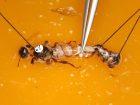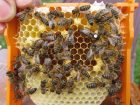
Features
Crop Protection
Inputs
Honeybee queens highly vulnerable to two neonics
October 14, 2015 By Dave Harrison
Oct. 14, 2015, Bern, Germany – Throughout the northern hemisphere beekeepers have struggled to maintain adequate numbers of honeybee colonies for crop pollination and honey production due to dramatic increases in colony deaths each year.
Recent surveys of beekeepers suggest that poor queen health is an important reason for these losses, but why queen health is now being affected is not understood. Click on image for more information.
In 2013, governments in Europe moved to partially restrict the use of these neonicotinoids while further risks assessments could be performed.
The province of Ontario followed suit in 2015.
FIRST SUCH STUDY ON HONEYBEE QUEENS
This is the first study to investigate the effects of neonicotinoids on honeybee queens. Its findings suggest that these insecticides may be contributing to bee colony mortality by affecting queen health, and it further strengthens calls for more thorough environmental risk assessments of these pesticides to protect bees and other beneficial organisms.
In recent years, beekeepers have had difficulties maintaining honeybee colonies throughout North America and Europe, and often experience dramatic winter mortalities.
“Alongside introduced parasites, it is believed that agricultural chemicals may play a role in these issues,” says lead author Geoff Williams of the University of Bern.
In 2013, governments in Europe took a precautionary approach by partially restricting the application of the widely used neonicotinoid pesticides thiamethoxam, clothianidin and imidacloprid, with the mandate to perform further environmental risk assessments. A new inter-governmental review will take place in the coming months.
Previous research suggests that these chemicals cause both lethal and sub-lethal effects on honeybee workers from exposure, but nothing is known about how they may affect queens.
A research team from the Institute of Bee Health at the University of Bern (Switzerland), from Agroscope at the Swiss Confederation (Switzerland), and from the Department of Biology at Acadia University (Canada), recently demonstrated in an article in the open-access journal SCIENTIFIC REPORTS (Nature Publishing Group) that honeybee queens are extremely vulnerable to the neonicotinoid pesticides thiamethoxam and clothianidin.
DIVERSE PHYSIOLOGICAL AND ANATOMICAL EFFECTS
The observation that honeybee queens are highly vulnerable to these common neonicotinoid pesticides is worrisome, but not surprising, says senior author Laurent Gauthier from the Swiss Confederation’s Agroscope.
“Beekeepers frequently cite poor queen health as a major cause of colony death each year.”
The study shows profound effects on queen physiology, anatomy and overall reproductive success.
The queen, as the sole egg-layer and the primary source of colony cohesion, is the most important individual in the colony; without her, the colony will eventually fail to function.
“This study, along with other recently published ones, supports calls for more thorough environmental risk assessments of agricultural chemicals to protect biodiversity and ecosystem functioning,” sais co-author Peter Neumann from Bern.
BEES, POLLINATION AND HONEY
Honeybees are complex social organisms that demonstrate female reproductive division of labour between the queen and workers within a colony. Queens release chemical pheromones essential for colony social organization and usually monopolize female reproduction, while workers carry out all other tasks necessary for colony maintenance.
Since there is only a single queen in each colony, queen health is crucial to colony survival. Soon after birth, each queen will embark on a series of mating flights to collect sperm from males called drones. Afterwards, she will return to her colony to lay eggs and be cared for by workers.
Honeybees, like all insect pollinators, provide crucial ecosystem and economic services. Annually in Europe and North America, millions of honeybee colonies produce honey and contribute to the pollination of a range of agricultural crops – from carrots to almonds to oilseed rape – that is valued at billions of Euros.
CAPTIONS
A marked honeybee queen used during the study. She is shown on a wax comb with adult workers, capped cells containing maturing workers, and open cells containing eggs that will develop into workers. (Photo: Geoffrey Williams, University of Bern).
Dissection of a honeybee queen used during the study. The opaque sphere shown at the tip of the forceps is the sperm storage organ of the queen called the spermatheca. (Photo: Geoffrey Williams, University of Bern).
An experimental honeybee queen returning from a mating flight. (Photo: Geoffrey Williams, University of Bern).
Print this page


